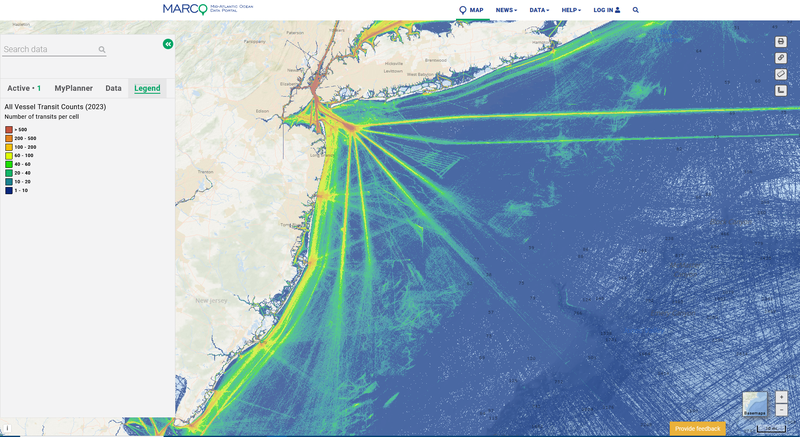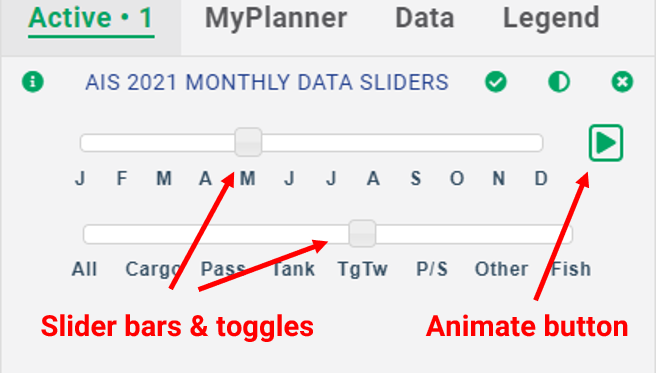A series of new maps based on Automatic Identification System (AIS) data show monthly and annual traffic patterns for several types of vessels in 2023.

Available in the Portal’s Maritime theme, the AIS Vessel Transit Counts (2023) and AIS 2023 Monthly Data Sliders collections include maps that depict traffic for all vessels carrying AIS technology and maps that break out activity for several specific vessel types. They include cargo, fishing, tug/tow and passenger vessels; pleasure craft/sailboats; tankers; and “other” vessels that don’t fit within these classifications. With the latest additions, the Portal now houses nearly a thousand AIS maps showing vessel activity for years and months dating back to 2011.
The new vessel traffic datasets and interactive maps were developed in collaboration with our partners from the Marine Cadastre, which obtained the data from the U.S. Coast Guard and processed it for regional and other partners to use. The data were then used by Northeast Ocean Data Portal to develop regional maps by vessel type and shared with the Mid-Atlantic Ocean Data Portal. Partners from the U.S. Coast Guard and the maritime industry have also contributed valuable input at numerous presentations and briefings, helping to guide how the data should be processed and presented to maximize their accuracy and usefulness.
Since 2002, large vessels operating in U.S. waters have been required to carry AIS transponders, which send automated signals to nearby ships, onshore infrastructure and satellites indicating their identity, purpose, course and speed. Originally envisioned as a post-9/11 security measure, AIS data is now used by the public and private sectors for a far wider range of uses, including maritime safety, ocean planning and environmental protection.
Reds, oranges and yellows in the maps indicate where vessel concentrations were highest, while cooler colors note where traffic was less intense. Specifically, the reds represent 100-meter grid cells where there were more than 500 transit counts, while the darkest blues show areas with 10 or less. (The Portal’s 2011, 2012 and 2013 maps display relative density rather than actual vessel transit counts.) See the Maritime section of the Portal’s Data Catalog for more information about the AIS data and download options.
Using the Monthly Sliders

Users can view annual maps by clicking on AIS Vessel Transit Counts (by desired year) for a dropdown menu of vessel types, or choose the AIS Monthly Data Sliders option to toggle through or animate monthly maps. Using the Slider and Animation Tool is easy. The following is a quick start guide.
- Click to activate the AIS Monthly Data Sliders layer for 2023 or any other year, found within the Maritime theme. (Load times may take several seconds, depending on technology and connection speeds.)
- Click on the "View Slider" button or switch from the Data tab to the Active tab to access the tool controls. Two slider bars will be available – a top bar to control the time interval (month) and a bottom one to select the vessel type.
- To automatically cycle through the monthly maps as an animation, click the play button icon to the right of the top slider bar. Users can also manually advance the toggle with a mouse to view a specific month.
- To change the data type (e.g. Cargo Vessel, Passenger Vessel), simply use the toggle to select from the available options.
Questions?
Have questions or comments on these maps? We’d like to hear from you. E-mail portal@midatlanticocean.org or fill out the “Provide Feedback” button at the bottom of this page.

